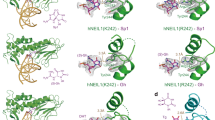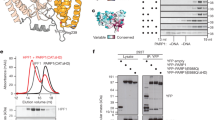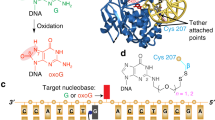Abstract
All organisms express dedicated repair enzymes for counteracting the cytotoxic and mutagenic potential of apurinic/apyrimidinic (AP) lesions, which would otherwise pose a serious threat to genome integrity. We present the predicted three-dimensional structure of the major human AP site-specific DNA repair endonuclease, HAP1, and show that an aspartate/histidine pair, in conjunction with a metal ion-coordinating glutamate residue, are critical for catalyzing the multiple repair activities of HAP1. We suggest that this catalytic mechanism is conserved in certain reverse transcriptases, but is distinct from the two metal ion-mediated mechanism defined for other hydrolytic nucleases.
This is a preview of subscription content, access via your institution
Access options
Subscribe to this journal
Receive 12 print issues and online access
$189.00 per year
only $15.75 per issue
Buy this article
- Purchase on Springer Link
- Instant access to full article PDF
Prices may be subject to local taxes which are calculated during checkout
Similar content being viewed by others
References
Lindahl, T. Instability and decay of the primary structure of DNA. Nature 362, 709–715 (1993).
Wallace, S. AP Endonucleases and DNA glycosylases that recognise oxidative DNA damage. Environ. molec. Mutagen. 12, 431–477 (1988).
Doetsch, P. & Cunningham, R. Enzymology of AP endonucleases. Mutation Research 236, 173–201 (1990).
Demple, B. & Harrison, L. Repair of oxidative damage to DNA: Enzymology and biology. A. Rev. Biochem. 63, 915–948 (1994).
Loeb, L. & Preston, B. Mutagenesis by AP sites. A. Rev. Genetics 20, 201–230 (1986).
Barzilay, G. & Hickson, I.D. Structure and function of apurinic/apyrimidinic endonucleases. BioEssays in the press.
Walker, L.J., Craig, R.B., Harris, A.L. & Hickson, I.D. A role for the human DNA repair enzyme HAP1 in cellular protection against DNA damaging agents and hypoxic stress. Nucleic Acids Res. 22, 4884–4889 (1994).
Ono, Y., Furuta, T., Ohmoto, T., Akiyama, K. & Seki, S. Stable expression in rat glioma cells of sense and antisense nucleic acids to a human multifunctional DNA repair enzyme, APEX nuclease. Mutation. Res. 315, 55–63 (1994).
Chen, D.S. & Olkowski, Z.L. Biological responses of human apurinic endonuclease to radiation-induced DNA damage. Ann. N.Y. Acad. Sci. 726, 306–308 (1994).
Cunningham, R.P., Saporito, S.M., Spitzer, S.G. & Weiss, B. Endonuclease IV (nfo) mutant of Escherichia coli. J. Bacteriol. 168, 1120–1127 (1986).
Saporito, S.M., Smith-White, B.J. & Cunningham, R.P. Nucleotide sequence of the xth gene of Escherichia coli K-12. J. Bacteriol. 170, 4542–4547 (1988).
Ramotar, D., Popoff, S.C., Gralla, E.B. & Demple, B. Cellular role of yeast Apn1 apurinic endonuclease/3′-diesterase: Repair of oxidative and alkylation DNA damage and control of spontaneous mutation. Molec. cell. Biol. 11, 4537–4544 (1991).
Robson, C., Milne, A., Pappin, D. & Hickson, I. Isolation of cDNA clones encoding an enzyme from bovine cells that repairs oxidative DNA damage in vitro: homology with bacterial DNA repair enzymes. Nucleic Acids Res. 19, 1087–1092 (1991).
Demple, B., Herman, T. & Chen, D. Cloning and expression of APE - a cDNA encoding the major human AP endonuclease. Definition of a family of DNA repair enzymes. Proc. natn. Acad. Sci. U.S.A. 88, 11450–11454 (1991).
Xanthoudakis, S. & Curran, T. Identification and characterisation of Ref-1, a nuclear protein that facilitates AP-1 DNA binding acticity. EMBO J. 11, 653–665 (1992).
Xanthoudakis, S., Miao, G.G., Wang, F. & Pan, Y.-C.E. Redox activation of Fos-Jun DNA binding activity is mediated by a DNA repair enzyme. EMBO J. 11, 3323–3335 (1992).
Walker, L.J., Robson, C.N., Black, E., Gillespie, D. & Hickson, I.D. Identification of residues in the human DNA repair enzyme HAP1 (Ref-1) that are essential for redox regulation of Jun DNA binding. Molec. cell. Biol. 13, 5370–5376 (1993).
Suck, D. & Oefner, C. Structure of DNase I at 2.0 A resolution suggests a mechanism for binding to and cutting DNA. Nature 321, 620–625 (1986).
Beeze, L.S. & Steitz, T.A. Structural basis for the 3′-5′ exonuclease activity of Escherichia coli DNA polymerase I: a two metal ion mechanism. EMBO J. 10, 25–33 (1991).
Mol, C.D., Kuo, C.-F., Thayer, M.M., Cunningham, R.P. & Tainer, J.A. Structure and function of the multifunctinal DNA repair enzyme exonuclease III. Nature 374, 381–386 (1995).
Barzilay, G., Walker, L.J., Robson, C.N. & Hickson, I.D. Site-directed mutagenesis of the human DNA repair enzyme HAP1: identification of residues important for AP endonuclease and RNase H activity. Nucleic Acids Res. 23, 1544–1550 (1995).
Volbeda, A., Lahm, A., Sakiyama, F. & Suck, D. Crystal structure of Penicillium citrinum P1 nuclease at 2.8 Å resolution. EMBO J. 10, 1607–1618 (1991).
Kabsch, W.J. Evaluation of single crystal X-ray diffraction data from a position sensitive detector. J. appl. Crystallogr. 21, 916–924 (1988).
McRee, D.E. A visual protein crystallographic software system for X11/XView. J. molec. Graph. 10, 44–47 (1992).
Tabor, S. Expression using the T7 RNA polymerase/promoter system. in Current Protocols in Molecular Biology (Wiley Interscience, New York; 1990).
Landt, O., Grunert, H. & Hahn, U. A general method for rapid site-directed mutagenesis using the polymerase chain reaction. Gene 96, 125–128 (1990).
Laemmli, U.K. Cleavage of structural proteins during the assembly of the head of bacteriophage T4. Nature 227, 680–685 (1970).
Robson, C.N. & Hickson, I.D. Isolation of cDNA clones encoding a human apurinic/apyrimidinic endonuclease that corrects DNA repair and mutagenesis defects. Nucleic Acids. Res. 19, 5519–5523 (1991).
Author information
Authors and Affiliations
Rights and permissions
About this article
Cite this article
Barzilay, G., Mol, C., Robson, C. et al. Identification of critical active-site residues in the multifunctional human DNA repair enzyme HAP1. Nat Struct Mol Biol 2, 561–568 (1995). https://doi.org/10.1038/nsb0795-561
Received:
Accepted:
Issue Date:
DOI: https://doi.org/10.1038/nsb0795-561
This article is cited by
-
Molecular snapshots of APE1 proofreading mismatches and removing DNA damage
Nature Communications (2018)
-
CiAPEX2 and CiP0, candidates of AP endonucleases in Ciona intestinalis, have 3′-5′ exonuclease activity and contribute to protection against oxidative stress
Genes and Environment (2017)
-
1H, 13C and 15N NMR assignments of Mg2+ bound form of UV inducible transcript protein (UVI31+) from Chlamydomonas reinhardtii
Biomolecular NMR Assignments (2015)
-
Goat milk supplemented with folic acid protects cell biomolecules from oxidative stress-mediated damage after anaemia recovery in comparison with cow milk
European Journal of Nutrition (2014)
-
Development and evaluation of human AP endonuclease inhibitors in melanoma and glioma cell lines
British Journal of Cancer (2011)



